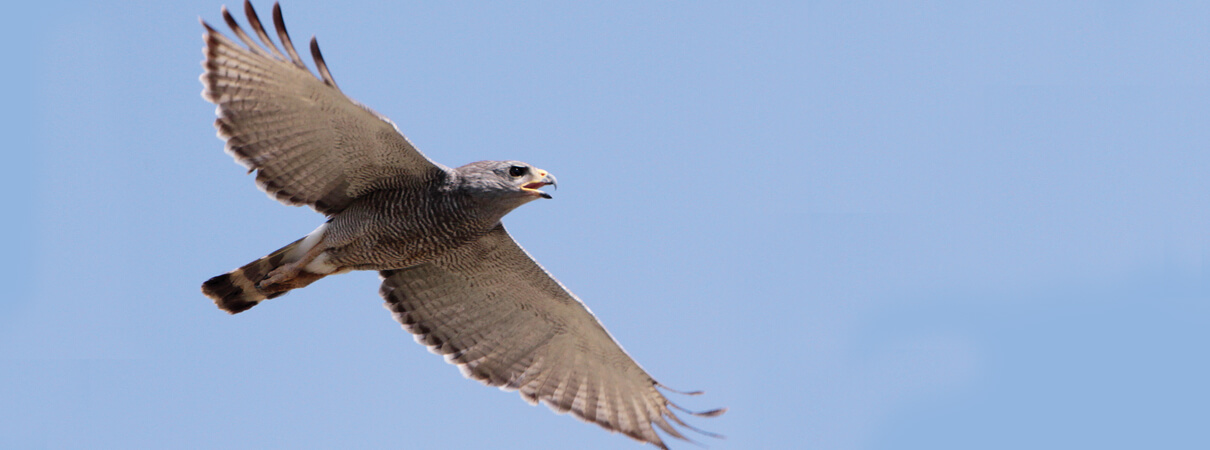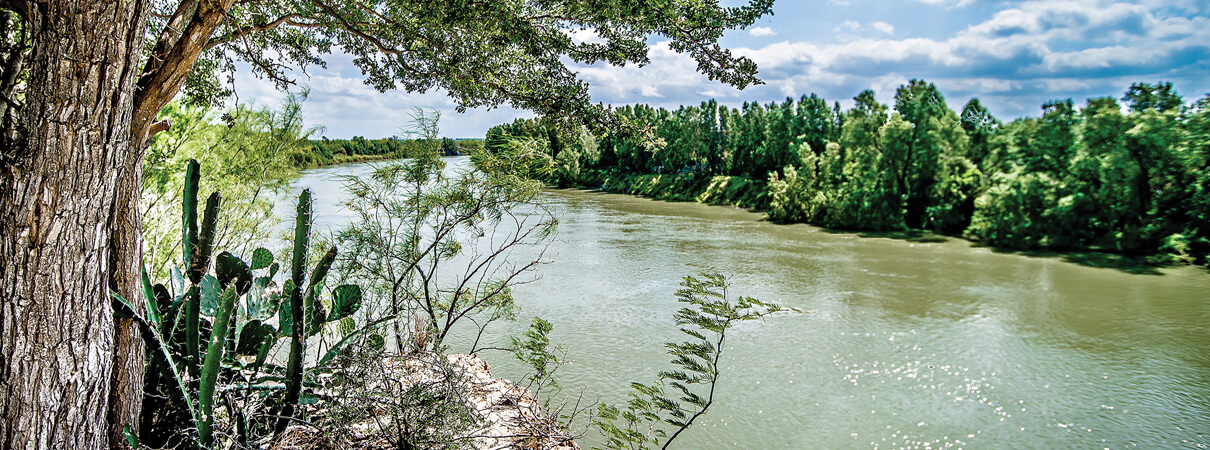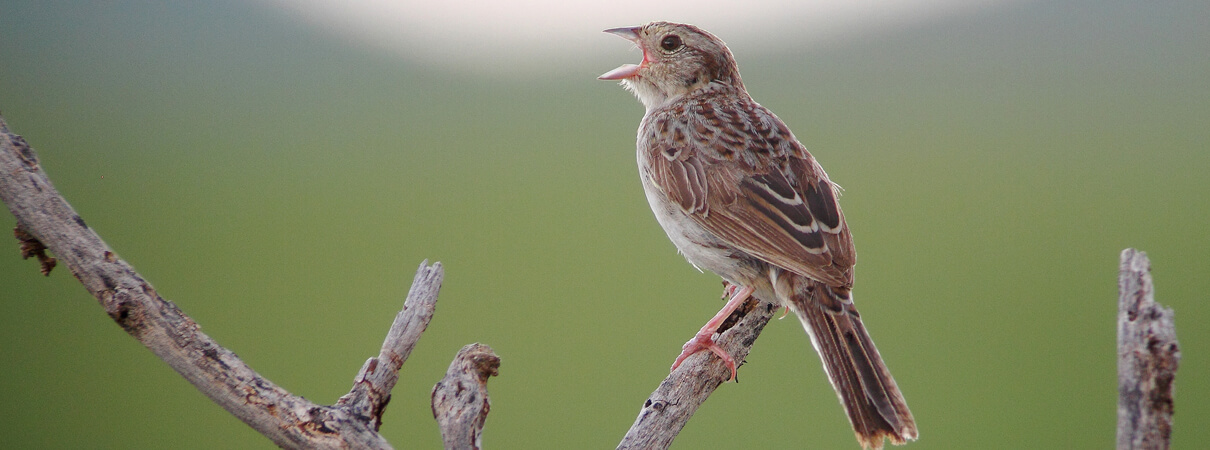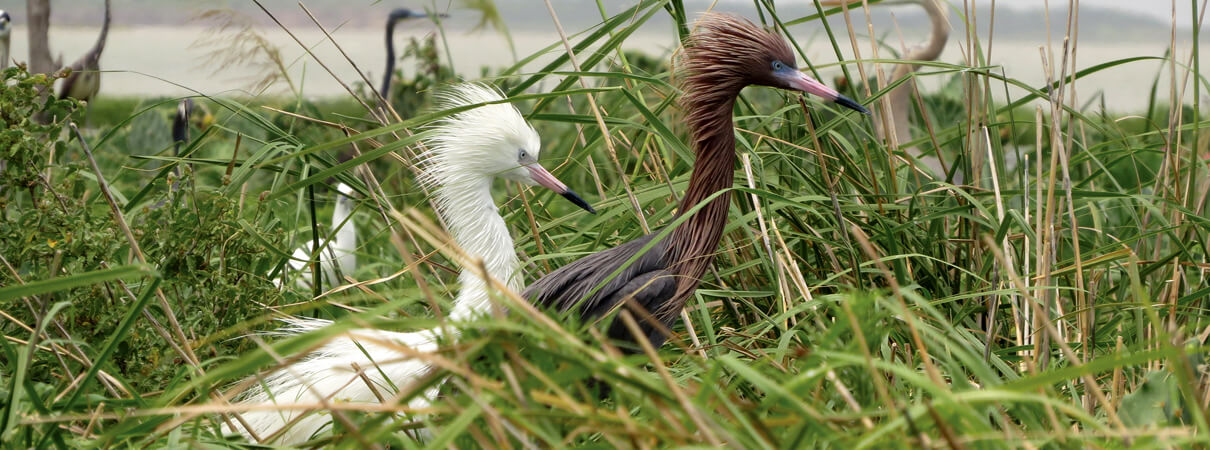Cross-border Conservation Restores Vital Habitat for Birds of the Rio Grande
The beautiful and diverse birds of the Rio Grande region move freely across the landscape, unaware of the political borders that divide the United States and Mexico. More than 700 species occur in this area, including at least 50 that show some combination of population declines, limited geographic distributions, or distinct threats to habitat. But the riparian forests, brushlands, grasslands, and desert these birds depend on face significant threats along both sides of the Rio Grande.
The Rio Grande Joint Venture (RGJV) — a partnership of conservation organizations that collaborate to protect and restore habitat for birds — is tackling these challenges, working in cooperation with a management board of state, federal, and nongovernmental organizations from two countries. ABC staff lead the RGJV with funding from the U.S. Fish and Wildlife Service.

Common Black-Hawk is one of the focal species of the Big Bend BirdScape, in Texas. Photo by Alfred Yan
“Some of the birds in our region are declining dramatically compared to other areas of the country,” says Aimee Roberson, the RGJV Coordinator at ABC. “This is primarily due to loss and degradation of their habitats. Our partners are dedicated to working together to overcome these threats across a large, binational landscape.”
The RGJV's roughly 63 million acres encompass a variety of priority bird habitats and several BirdScapes as well. BirdScapes are areas that ABC has identified as particularly important for migratory bird conservation. Each BirdScape aims to protect and restore suitable habitat for a suite of migratory and resident birds, often maintaining working lands for the people who live there.
Green Corridors in the Desert
Accounts from the 1800s describe the Chihuahuan Desert as dominated by native grasses and scattered shrubs with riverside forests and desert wetlands called ciénegas forming green corridors across the landscape.

The Rio Grande in Big Bend, Texas. Photo by Dmitry Shlepkin_Shutterstock
Historically, unsustainable range management contributed to the degradation and loss of these grasslands. Now the land is drying out, and shrubs are encroaching. ABC and a variety of partners — including the Bird Conservancy of the Rockies and Mexico's Pronatura Noreste — are already succeeding in their efforts to address these problems in the grasslands of two of the region's BirdScapes, Valles Centrales and El Tokio, in Mexico.
Riparian corridors are the focus of conservation work within the 704,000-acre Big Bend BirdScape, in Texas, which includes portions of Big Bend National Park as well as private property. Roberson oversees this BirdScape. She works with partner organizations and agencies to rehabilitate riverside forests along Terlingua Creek and other tributaries of the Rio Grande, where cottonwood and willow forests once teemed with birds and beaver. Focal species of this area include Yellow-billed Cuckoo, Gray Hawk, and Common Black-Hawk.
Roberson collaborates with the Texas Parks and Wildlife Department, the National Park Service, and the U.S. Fish and Wildlife Service to restore riverside forests by replanting willows, cottonwoods, and other native plants throughout the watershed, including in Big Bend National Park. The organizations also provide technical and financial assistance to private landowners who are interested in replanting vegetation along the waterways on their own properties. In a state such as Texas where most land is privately held, landowners play a critical role in restoring bird habitat. For example, on the 272,000-acre O2 Ranch, which contains the headwaters of Terlingua Creek, owners Lykes Brothers, Inc. is working with the RGJV to restore both grasslands and riparian habitats to benefit wildlife.

ABC is working with partner organizations and agencies to rehabilitate riverside forests along tributaries of the Rio Grande that are home to Gray Hawk (pictured) and many other species. Photo by Larry Thompson
“By working with public and private landowners throughout the watershed, we can restore habitat for bird species,” Roberson says. “We want to make the creek healthy again to benefit birds and people.”
Native Grasslands for Birds and Butterflies of the Rio Grande
Riparian corridors and grasslands are also important conservation priorities in the Tamaulipan Brushlands, an area spanning the U.S.-Mexico border on either side of the Rio Grande. Here, the landscape is dominated by an abundance of non-native grasslands, remnants of native grasslands, and Tamaulipan thornscrub — vegetation characterized by thorny shrubs and trees, plus grasses and cacti.
These brushlands are home to the South Texas Monarch BirdScape. That's where Jesús Franco, RGJV Assistant Coordinator, is working to establish a program that will restore native grasslands worn down by invasive brush, non-native grasses, unsustainable rangeland management, and the alteration of natural fire patterns. Improving these areas will give a boost to a number of declining birds, including Eastern Meadowlark, Cassin's Sparrow, and Northern Bobwhite. This BirdScape is also a major waystation for migrating Monarch butterflies, providing breeding and stopover habitat.

More than 700 species occur in the Rio Grande region, but the riparian forests, brushlands, grasslands, and desert these birds depend on face significant threats along both sides of the river. Photo by digidreamgrafix_Shutterstock
“The South Texas Monarch BirdScape covers eight counties in south Texas, mostly on private land,” Franco says. “We are working with county biologists and other local and regional partners, including the Texas Parks and Wildlife Department, Natural Resources Conservation Service, and the Caesar Kleberg Wildlife Research Institute, to promote native grassland restoration programs and determine which conservation practices are best for ranchers and grassland-dependent wildlife.”
The RGJV recently received a grant from the National Fish and Wildlife Foundation to establish a Grassland Restoration Incentive Program (GRIP) — the same program being implemented by ABC's Jim Giocomo in the Oaks and Prairies Joint Venture in central and northern Texas and Oklahoma. This program encourages private landowners to use grassland management practices to improve habitat for pollinators and grassland birds such as bobwhite.
“We will adapt the GRIP program to local conditions in South Texas,” Franco says. “For example, brush management practices here are more effective for grassland restoration than in other regions. Here, land managers favor mechanical or chemical removal of invasive shrubs, rather than, say, prescribed burning, which is widely used elsewhere.”
Through the GRIP program, Franco says, conservationists are effectively addressing some of the issues causing the decline of grassland birds and pollinators. “Private landowners love the streamlined technical and financial assistance process. Conservation partners love the additional tool in their conservation tool box. And wildlife that depend on healthy native grasslands sure benefit from the additional usable space,” he says. “It's a win-win-win situation.”

Cassin's Sparrow is one of many species that will benefit from the restoration of native grasslands worn down by invasive brush, non-native grasses, unsustainable rangeland management, and the alteration of natural fire patterns. Photo by Greg Homel
Shorebirds and More in the Coastal Prairie
The Rio Grande Joint Venture also includes important areas of coastal prairie habitat south of the Rio Grande in Mexico, where future work in the Laguna Madre BirdScape is planned. The Laguna Madre, a long, shallow, saline lagoon that spans the border, is important habitat for both resident and migratory birds.
Conservation in this BirdScape will focus on the protection and restoration of the lagoon's interior islands, plus the riparian corridors and freshwater wetlands that feed into the lagoon. Most of these riparian corridors originate in the Tamaulipan Brushlands.

Reddish Egret is one of the focal species of the Laguna Madre. Photo by Alfredo Alvarez
ABC is already working with partners in Mexico and has identified the priority birds of this area. Reddish Egret, Black Skimmer, and Wilson's Plover are among the focal birds of the Laguna Madre. An estimated 80 percent of the global population of another focal species, the Redhead, winters here.
A Better Future for Birds
The collaborative efforts of conservation partners within these BirdScapes are helping to achieve the Rio Grande Joint Venture's vision: ecosystems that support thriving and diverse communities of birds, other wildlife, and people across the landscape, across the border, and into the future.
“Jesús and I love our jobs because we work with a diversity of people and organizations in the U.S. and Mexico who are so enthusiastic and absolutely dedicated to conserving birds,” Roberson says. “We help people find ways to work better together so that we can accomplish more than any of our organizations could alone, and we have fun doing it.”
This article first appeared in the Fall 2017 issue of Bird Conservation magazine.
 Gemma Radko is ABC's Communications and Media Manager. She graduated from Allegheny College with degrees in Art and Biology and has over 20 years of graphic design, writing, and editing experience. Gemma is an avid birder and is a member of both the Montgomery and Frederick chapters of the Maryland Ornithological Society, often leading field trips for members. A licensed bird bander, she has in the past run a MAPS (Monitoring Avian Productivity and Survivorship) station.
Gemma Radko is ABC's Communications and Media Manager. She graduated from Allegheny College with degrees in Art and Biology and has over 20 years of graphic design, writing, and editing experience. Gemma is an avid birder and is a member of both the Montgomery and Frederick chapters of the Maryland Ornithological Society, often leading field trips for members. A licensed bird bander, she has in the past run a MAPS (Monitoring Avian Productivity and Survivorship) station.


















































